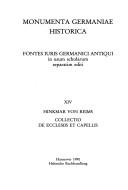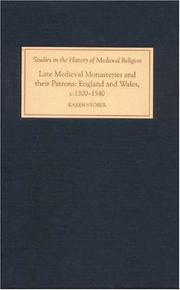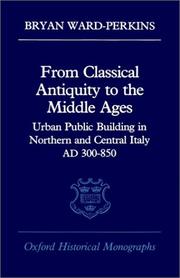| Listing 1 - 10 of 17 | << page >> |
Sort by
|
Book
ISBN: 1621896447 9781621896449 1610979907 9781610979900 Year: 2013 Publisher: Eugene, Oregon Wipf & Stock
Abstract | Keywords | Export | Availability | Bookmark
 Loading...
Loading...Choose an application
- Reference Manager
- EndNote
- RefWorks (Direct export to RefWorks)
Patronage, Ecclesiastical --- Ecclesiastical patronage --- Benefices, Ecclesiastical --- Church and state --- Church polity --- Church property --- Clergy --- Church of Scotland --- History.
Book
ISBN: 3412029866 9783412029869 Year: 1987 Volume: 15 Publisher: Köln Böhlau
Abstract | Keywords | Export | Availability | Bookmark
 Loading...
Loading...Choose an application
- Reference Manager
- EndNote
- RefWorks (Direct export to RefWorks)
Patronage, Ecclesiastical (Canon law) --- Patronage, Ecclesiastical --- History --- 348.7 --- -Patronage, Ecclesiastical --- -Ecclesiastical patronage --- Benefices, Ecclesiastical --- Church and state --- Church polity --- Church property --- Clergy --- Canon law --- Benefices, Ecclesiastical (Canon law) --- Canoniek staatsrecht --- -Canoniek staatsrecht --- 348.7 Canoniek staatsrecht --- -348.7 Canoniek staatsrecht --- Ecclesiastical patronage --- Patronage, Ecclesiastical (Canon law) - History --- Patronage, Ecclesiastical - Germany - History

ISBN: 3775253327 9783775253321 Year: 1990 Volume: 14 Publisher: Hannover Hahnsche Buchhandlung
Abstract | Keywords | Export | Availability | Bookmark
 Loading...
Loading...Choose an application
- Reference Manager
- EndNote
- RefWorks (Direct export to RefWorks)
Canon law --- Ecclesiastical law --- Droit ecclésiastique --- Patronage, Ecclesiastical (Canon law) --- Patronage, Ecclesiastical --- History --- Sources --- 348.15*3 --- -Patronage, Ecclesiastical --- -Ecclesiastical patronage --- Benefices, Ecclesiastical --- Church and state --- Church polity --- Church property --- Clergy --- Benefices, Ecclesiastical (Canon law) --- Kerkelijk recht collecties 852-1140 --- -Sources --- Sources. --- History. --- -Kerkelijk recht collecties 852-1140 --- 348.15*3 Kerkelijk recht collecties 852-1140 --- -348.15*3 Kerkelijk recht collecties 852-1140 --- Ecclesiastical patronage --- Droit ecclésiastique --- History&delete& --- Patronage, Ecclesiastical (Canon law) - History - Sources --- Patronage, Ecclesiastical - France - History --- HINCMAR, ARCHEVEQUE DE REIMS, 806?-882 --- OEUVRES --- EDITION CRITIQUE
Book
ISSN: 09552480 ISBN: 9781843838128 1843838125 9781782040811 1299199976 1782040811 Year: 2013 Volume: v. 40 Publisher: Suffolk Boydell & Brewer
Abstract | Keywords | Export | Availability | Bookmark
 Loading...
Loading...Choose an application
- Reference Manager
- EndNote
- RefWorks (Direct export to RefWorks)
"While there has been work on the nobility as patrons of monasteries, this is the first real study of them as patrons of parish churches, and is thus the first study to tackle the subject as a whole. Illustrated with a wealth of detail, it will become an indispensable work of reference for those interested in lay patronage and the Church more generally in the middle ages." Professor David Carpenter, Department of History, King's College London. This book provides the first full-length, integrated study of the ecclesiastical patronage rights of the nobility in medieval England. It examines the nature and extent of these rights, how they were used, why and for whom they were valuable, what challenges lay patrons faced, and how they looked to the future in making gifts to the Church. It takes as its focus the thirteenth century, a critical period for the survival and development of these rights, being a time of ambitious Church reform, of great change in patterns of land ownership in the ranks of the higher nobility, and of bold assertion by the English Crown of its claims to control Church property. The thirteenth century also saw a proliferation of record keeping on the part of kings, bishops and nobility, and the author uses new evidence from a range of documentary sources to explore the nature of the relationships between the English nobility, the Church and its clergy, a relationship in which patronage was the essential feature. Dr Elizabeth Gemmill is University Lecturer in Local History and Fellow of Kellogg College. University of Oxford.
Patronage, Ecclesiastical --- Nobility --- Patronage ecclésiastique --- Noblesse --- History --- Histoire --- England --- Angleterre --- Church history --- Histoire religieuse --- Patronage ecclésiastique --- Noble class --- Noble families --- Nobles (Social class) --- Peerage --- Upper class --- Aristocracy (Social class) --- Titles of honor and nobility --- Ecclesiastical patronage --- Benefices, Ecclesiastical --- Church and state --- Church polity --- Church property --- Clergy --- Anglii︠a︡ --- Inghilterra --- Engeland --- Inglaterra --- Anglija --- England and Wales --- Church reform. --- Church. --- Clergy. --- Control Church property. --- Documentary sources. --- Ecclesiastical patronage. --- Elizabeth Gemmill. --- English Crown. --- English nobility. --- Kellogg College. --- King's College London. --- Lay patrons. --- Local History. --- Medieval England. --- Nobility. --- Parish churches. --- Patronage rights. --- Record keeping. --- Relationships. --- Thirteenth century. --- University of Oxford.
Book
ISBN: 0520052781 9780520052789 Year: 1985 Publisher: Berkeley, Calif.
Abstract | Keywords | Export | Availability | Bookmark
 Loading...
Loading...Choose an application
- Reference Manager
- EndNote
- RefWorks (Direct export to RefWorks)
Christian church history --- anno 1200-1499 --- anno 1100-1199 --- Great Britain --- Hermits --- Patronage, Ecclesiastical --- History --- England --- Church history --- -Patronage, Ecclesiastical --- -Church history --- -Christianity --- Ecclesiastical history --- History, Church --- History, Ecclesiastical --- Christianity --- Ecclesiastical patronage --- Benefices, Ecclesiastical --- Church and state --- Church polity --- Church property --- Clergy --- Anchorites --- Eremites --- Persons --- Hermitages --- Recluses --- -Hermits --- History. --- -History --- -Christian church history --- Hermits - England --- Patronage, Ecclesiastical - England - History --- England - Church history - 1066-1485
Book
ISBN: 0773429921 9780773429925 9780773437890 0773437894 Year: 2010 Publisher: Lewiston Edwin Mellen Press
Abstract | Keywords | Export | Availability | Bookmark
 Loading...
Loading...Choose an application
- Reference Manager
- EndNote
- RefWorks (Direct export to RefWorks)
This book examines Church patronage in late-eighteenth century Britain, during the administrations of Lord North (1770-1782) and the first government of William Pitt the Younger (1783-1801). The clergy were one of the foremost of the Hanoverian professions, with its patronage a source of interest to the King, politicians, the landed elite and the universities. By concentrating on the appointments of clergy below the bench of bishops, the book gives a clear account of the complex relationships and criteria which underlay the four patronage networks. It will greatly increase our understanding of
Church of England -- Benefices -- History -- 18th century. --- England -- Church history -- 18th century. --- Patronage, Ecclesiastical -- England -- History -- 18th century. --- Patronage, Ecclesiastical --- Religion --- Philosophy & Religion --- Christianity --- Ecclesiastical patronage --- Benefices, Ecclesiastical --- Church and state --- Church polity --- Church property --- Clergy --- History --- Church of England --- Benefices --- England --- Church history --- Anglican Church --- Anglikanskai︠a︡ t︠s︡erkovʹ --- Ecclesia Anglicana --- Kirche von England --- United Church of England and Ireland
Book
ISBN: 1282987577 9786612987571 1846156998 086193301X Year: 2009 Publisher: Woodbridge, U.K. ; Rochester, N.Y. : Royal Historical Society : Boydell Press,
Abstract | Keywords | Export | Availability | Bookmark
 Loading...
Loading...Choose an application
- Reference Manager
- EndNote
- RefWorks (Direct export to RefWorks)
A detailed examination of the life and career of Cardinal Bendinello Sauli - notorious for his involvement in a plot to murder the Pope. Cardinal Bendinello Sauli died in disgrace in 1518, implicated, rightly or wrongly, in a conspiracy to assassinate the then Pope, Leo X. This book, based on extensive archival research in Genoa and Rome, traces Sauli's rise and fall, setting one man's life and career against a background of political turmoil and intrigue, and offering new perspectives on the patronal links which bound pope, cardinals and their family and courtiers so closely together. It plots his elevation to ecclesiastical eminence through the efforts of his family who were financiers to the pope; and it examines his apogee as cardinal-patron both of humanists and of some of the leading artists of his day such as Sebastiano del Piombo and Raphael. The plot to murder the pope is also studied in depth; the author examines the surviving evidence relating to the plot and reveals new archival material which supports its existence in the eyes of the law and Sauli's involvement in it. In addition, she explores Sauli's role as a man of the Church and his administration of his benefices. HELEN HYDE is an independent scholar who studied at the universities of Lancaster and London. Her previous publications include articles on the Sauli family and early sixteenth-century Genoa.
Patronage, Ecclesiastical --- Cardinals --- Ecclesiastical patronage --- Benefices, Ecclesiastical --- Church and state --- Church polity --- Church property --- Clergy --- History --- Sauli, Bendinello, --- Leo --- De' Medici, Giovanni, --- Leone --- Medici, Giovanni de', --- de Médicis, Jean --- Cardinal Bendinello Sauli. --- Church. --- Genoa. --- Jurisprudence. --- Papacy. --- Papal Conspiracy. --- Patronage. --- Politics. --- Renaissance Italy. --- Sixteenth Century.
Book
ISBN: 3428065204 Year: 1988 Volume: 38 Publisher: Berlin Duncker & Humblot
Abstract | Keywords | Export | Availability | Bookmark
 Loading...
Loading...Choose an application
- Reference Manager
- EndNote
- RefWorks (Direct export to RefWorks)
Patronage, Ecclesiastical --- Patronage ecclésiastique --- History --- Histoire --- Catholic Church --- Eglise catholique --- Clergy --- Clergé --- Italy --- Italie --- Church history --- Histoire religieuse --- 27 <45> "15/17" --- 348.42 --- -Ecclesiastical patronage --- Benefices, Ecclesiastical --- Church and state --- Church polity --- Church property --- Kerkgeschiedenis--Italië--Moderne Tijd --- Kerkelijk vermogensrecht. Revenus. Prebenden. Beneficieen--(canon 1409-1551) --- -Catholic Church --- -Church of Rome --- Roman Catholic Church --- Katholische Kirche --- Katolyt︠s︡ʹka t︠s︡erkva --- Römisch-Katholische Kirche --- Römische Kirche --- Ecclesia Catholica --- Eglise catholique-romaine --- Katolicheskai︠a︡ t︠s︡erkovʹ --- Chiesa cattolica --- Iglesia Católica --- Kościół Katolicki --- Katolicki Kościół --- Kościół Rzymskokatolicki --- Nihon Katorikku Kyōkai --- Katholikē Ekklēsia --- Gereja Katolik --- Kenesiyah ha-Ḳatolit --- Kanisa Katoliki --- כנסיה הקתולית --- כנסייה הקתולית --- 가톨릭교 --- 천주교 --- -History --- Church history. --- -Kerkgeschiedenis--Italië--Moderne Tijd --- 348.42 Kerkelijk vermogensrecht. Revenus. Prebenden. Beneficieen--(canon 1409-1551) --- Patronage ecclésiastique --- Clergé --- Ecclesiastical patronage --- History. --- Church of Rome

ISBN: 1843832844 9781843832843 9781846155628 9786612185588 1282185586 1846155622 Year: 2007 Volume: 29 Publisher: Suffolk Boydell & Brewer
Abstract | Keywords | Export | Availability | Bookmark
 Loading...
Loading...Choose an application
- Reference Manager
- EndNote
- RefWorks (Direct export to RefWorks)
This book challenges the orthodox view that lay patronage of monasteries dwindled in significance throughout the middle ages. Lay patronage of religious houses remained of considerable importance during the late medieval period; but this is the first full-length study dedicated to the subject. Based on a wide range of medieval documentary sources, including wills, monastic registers, inquisitions post mortem, cartularies and episcopal registers, this book traces the descent of these later patrons and assesses their activities, in particular their bequests and benefactions, their involvement in the affairs of their houses, and their burials in the conventual churches; and it argues that the ties which bound the two parties together, whether amicable, indifferent or abusive, continued right up until the Dissolution brought monastic life in England and Wales to an end. KAREN SToÌBER is a Lecturer in Medieval History at the University of Aberystwyth.
Monasteries --- Patronage, Ecclesiastical --- Monastic and religious life --- Monastères --- Patronage ecclésiastique --- Vie religieuse et monastique --- History. --- History --- Histoire --- 271 <420> "13/15" --- Ordres religieux. Congregations religieuses. Monachisme--Engeland--?"13/15" --- Monastères --- Patronage ecclésiastique --- Ecclesiastical patronage --- Benefices, Ecclesiastical --- Church and state --- Church polity --- Church property --- Clergy --- Monastic life --- Spirituality (in religious orders, congregations, etc.) --- Monasticism and religious orders --- Spiritual life --- Vows --- Cloisters (Religious communities) --- Friaries --- Religious institutions --- Scriptoria --- Christianity

ISBN: 0198218982 Year: 1984 Publisher: Oxford Oxford university press
Abstract | Keywords | Export | Availability | Bookmark
 Loading...
Loading...Choose an application
- Reference Manager
- EndNote
- RefWorks (Direct export to RefWorks)
Public buildings --- Architecture, Classical --- Architecture, Medieval --- Patron and client --- Patronage, Ecclesiastical --- Bâtiments publics --- Architecture antique --- Architecture médiévale --- Patron et client --- Patronage ecclésiastique --- History --- Histoire --- -Architecture, Medieval --- -Patron and client --- -Public buildings --- -Government buildings --- Buildings --- Public works --- Civic centers --- Ecclesiastical patronage --- Benefices, Ecclesiastical --- Church and state --- Church polity --- Church property --- Clergy --- Clientela --- Clientelism --- Patronage, Roman --- Middle Ages --- Classical architecture --- Classical antiquities --- Patron and client. --- History. --- -History --- Bâtiments publics --- Architecture médiévale --- Patronage ecclésiastique --- Government buildings
| Listing 1 - 10 of 17 | << page >> |
Sort by
|

 Search
Search Feedback
Feedback About UniCat
About UniCat  Help
Help News
News